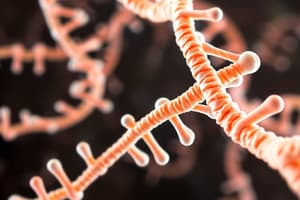Podcast
Questions and Answers
What is a characteristic feature of direct immunostaining compared to indirect immunostaining?
What is a characteristic feature of direct immunostaining compared to indirect immunostaining?
In flow cytometry, what does the direction of light scattering correlate to?
In flow cytometry, what does the direction of light scattering correlate to?
What is the primary goal of Fluorescence Activated Cell Sorting (FACs)?
What is the primary goal of Fluorescence Activated Cell Sorting (FACs)?
Which of the following best describes the purpose of an indirect ELISA?
Which of the following best describes the purpose of an indirect ELISA?
Signup and view all the answers
What distinguishes Northern blotting from Southern blotting?
What distinguishes Northern blotting from Southern blotting?
Signup and view all the answers
What type of gel is typically used for protein electrophoresis?
What type of gel is typically used for protein electrophoresis?
Signup and view all the answers
What can be a limitation of PCR?
What can be a limitation of PCR?
Signup and view all the answers
What is the principle behind mass spectrometry?
What is the principle behind mass spectrometry?
Signup and view all the answers
Study Notes
Nucleic Acids
- Techniques used to investigate nucleic acids include PCR, RT-qPCR, in situ hybridization, and blotting techniques like Southern blotting
- PCR: Uses a polymerase that amplifies a targeted sequence of DNA
- RT-qPCR: Measures the quantity of a specific RNA transcript
- In situ hybridization: Identifies the presence of specific DNA or RNA sequences within intact cells and tissues
- Southern blotting: Detects specific DNA sequences in a sample by using labelled probes
Protein
- Techniques used to investigate proteins include immunostaining, western blotting, electrophoresis, and mass spectrometry
- Immunostaining: Uses antibodies to stain cells, identifying specific proteins
- Western blotting: Detects and quantifies specific proteins in a sample through electrophoresis and blotting
- Electrophoresis: Separates proteins based on their size, charge, or other properties
- Mass spectrometry: Identifies, measures, and quantifies molecules using their mass-to-charge ratio
Immunostaining
- Uses antibodies to stain cells and identify specific proteins
- Direct immunostaining: uses a primary antibody with fluorophores, offering high specificity but lower detection sensitivity
- Indirect immunostaining: Less specific but easier to detect, uses a secondary antibody that binds to the primary antibody, often labeled with a visible tag
Immunocytochemistry
- Immunostaining technique used to detect proteins in cultured cells
Immunohistochemistry
- Immunostaining technique used to detect proteins in tissue sections
Immunofluorescence
- Immunostaining technique that uses fluorescent dyes to visualize the location of specific molecules in tissues or cells
Antibodies
- Biological molecules that specifically bind to and neutralize antigens
- Monoclonal antibodies: Produced by a clone of a single B cell, highly specific and uniform
- Polyclonal antibodies: Produced by multiple B cells, less specific but more readily available
Flow Cytometry
- Uses lasers and detectors to analyze physical and chemical characteristics of single cells as they pass through a laser beam
- Measures cell size, granularity, and fluorescence properties (based on antibody labeling)
- Can be used to analyze different cell populations within a sample, based on size, granularity, and specific markers
- Limitations: Limited to identifying cell populations based on predetermined markers and does not provide information about the cell's internal structure
Fluorescence Activated Cell Sorting (FACS)
- Specialized type of flow cytometry that physically sorts cells based on their characteristics
ELISA
- Enzyme-linked immunosorbent assay, a plate-based assay that uses antibodies to detect and quantify specific proteins or other molecules
- Direct ELISA: Uses an antibody directly conjugated to an enzyme, simplifying the process but reducing sensitivity
- Indirect ELISA: Uses a secondary antibody, which amplifies the signal and increases sensitivity
- Sandwich ELISA: Uses two antibodies, one to capture and another to detect the target molecule
- Competitive ELISA: Uses a target molecule to compete with an antibody for binding to the plate, providing a negative correlation between signal and target
- Multiplex ELISA: Simultaneously measure multiple analytes in a single sample, increasing efficiency and throughput
In situ hybridization
- Detects specific DNA or RNA sequences within intact cells or tissues
- Used to study gene expression and localization of specific transcripts
- Uses probes (labeled single-stranded DNA or RNA molecules) that recognize and bind to complementary sequences in the target nucleic acid
PCR
- Polymerase chain reaction, amplifies a specific DNA sequence, allowing researchers to study and analyze genes and genetic variations
- Utilizes a heat-tolerant polymerase enzyme to replicate the DNA sequence, generating copies of the target sequence
- Enables detection and quantification of specific DNA sequences in a sample
Reverse Transcriptase - Quantitative Polymerase Chain Reaction (RT-qPCR)
- Quantifies specific RNA transcripts in a sample, providing a method for studying gene expression
- Reverse transcriptase converts mRNA to cDNA, which is then amplified through qPCR
- Provides information about the abundance of specific transcripts
PCR Limitations
- PCR reactions can be prone to errors, leading to inaccurate results
- Primers used in PCR might bind to unintended sequences, resulting in false-positive data
- PCR is sensitive to contamination, which can lead to erroneous results
Electrophoresis
- Separates molecules based on their size and charge
- Agarose gel electrophoresis: Used primarily for separating DNA fragments based on their size
- Polyacrylamide gel electrophoresis: Separates proteins based on their size and charge
Post-Gel Analysis
- Visualizing and quantifying the separated molecules after electrophoresis
- Ethidium bromide: A fluorescent dye used to visualize DNA bands in agarose gels
- Coomassie blue, silver nitrate, and spyro ruby: Dyes used to visualize protein bands in polyacrylamide gels
Blotting Techniques
- Techniques for transferring biological molecules from a gel matrix onto different membranes
- Western blotting: Quantifies and identifies specific proteins in a sample
- Southern blotting: Identifies specific DNA sequences using labelled probes
- Northern blotting: Identifies specific RNA sequences using labelled probes
Mass Spectrometry
- Identifies, measures, and quantifies molecules based on their mass-to-charge ratio
- Used to analyze proteins, peptides, and other biomolecules
- Widely used in proteomics, metabolomics, and drug discovery
Mass Spectrometry Methods
- Matrix-assisted laser desorption/ionization (MALDI)
- Electrospray ionization (ESI)
- Gas chromatography-mass spectrometry (GC-MS)
- Liquid chromatography-mass spectrometry (LC-MS)
Studying That Suits You
Use AI to generate personalized quizzes and flashcards to suit your learning preferences.
Related Documents
Description
Explore various techniques used to investigate nucleic acids and proteins in this quiz. Learn about PCR, RT-qPCR, immunostaining, and mass spectrometry among others. This quiz provides a comprehensive overview of laboratory methods essential for molecular biology.




